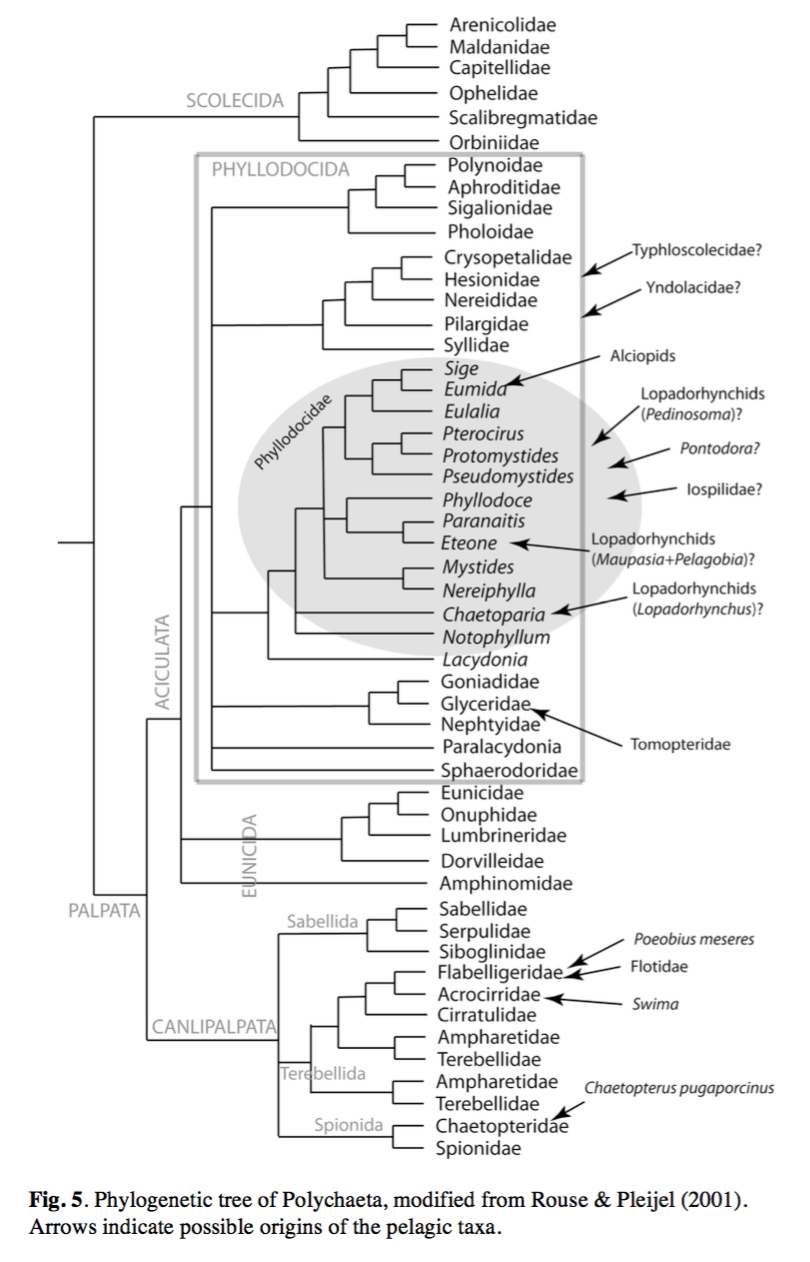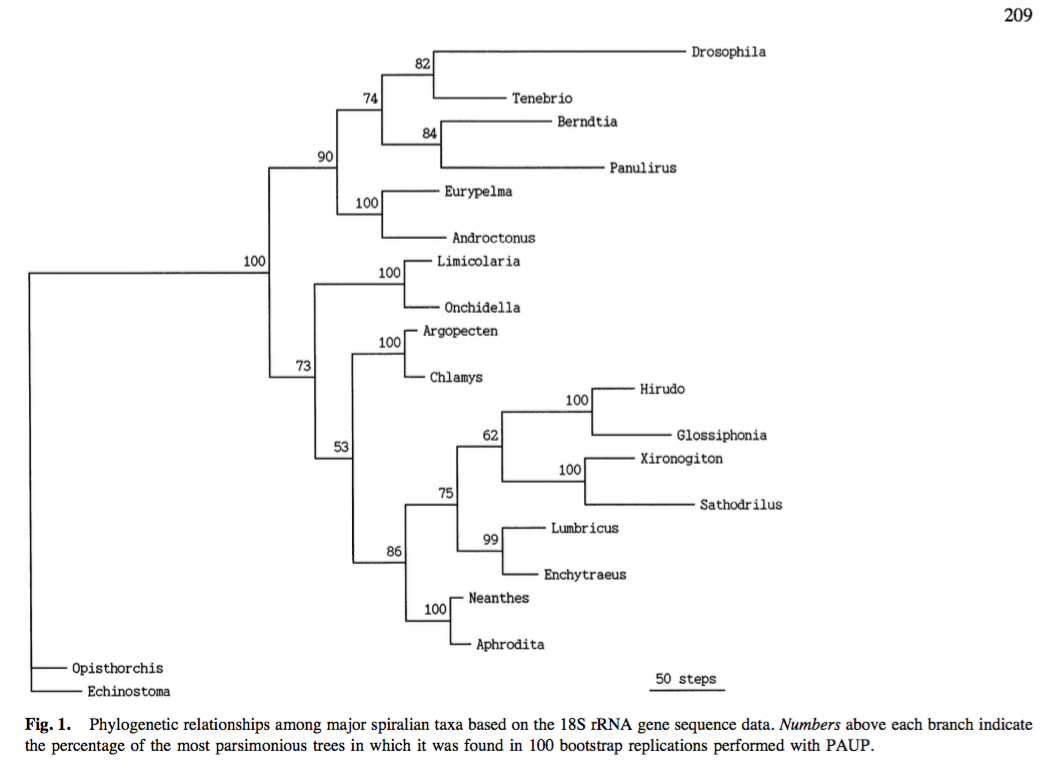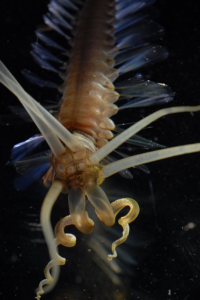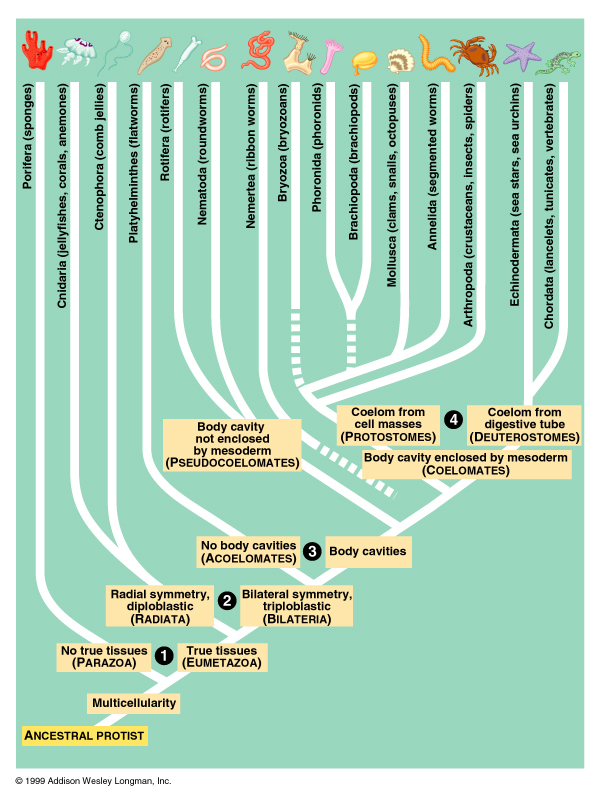Week 6 Blog Post – Annelida – Revised 12.1.17
Posted by kflani on December 2, 2017
Filed under Annelida
Annelid Phylogenetics
Introduction
Each week in Invertebrate Biology begins with our professor presenting a photo of a unique (and, hopefully, unknown to us) invertebrate which we attempt to place into a phylum. This week’s photo is below. Do you know what phylum it belongs to?
There are striking characteristics of this organism that I noticed immediately. Firstly, it has segments. Next, I noticed that it has bristled paddle-like “fins”. It has a worm-like body shape. And finally, it has a tentacled head. These one-of-a-kind traits led me to placing it within the annelida phylum. From there, I guessed it was a polychaete – a mainly marine – bristled worm. It wasn’t until I came across a National Geographic article that I could definitively say it was a squid worm, Teuthidodrilus samae, discovered by Karen Osborn in 20071.
What I find fascinating about our class’s weekly challenge of identifying the invertebrate is that our deductions are similar to that of renowned scientists when they discover an unknown organism. Granted, they do more extensive hypothesizing and testing and have more knowledge, but they make the same assumptions. The superficial characteristics that I used to determine the organism has been used to place it on a phylogenetic tree.
Scientists gather both molecular (genetic) and morphological (trait and characteristic) data to determine where a particular organism fits in evolutionary history2. Annelida is a phylum whose evolutionary history has been debated for years and represented in a few ways throughout time.3. Below are two phylogenetic trees of the animal kingdom. Can you interpret the difference in the placement of annelida between the two trees?

Kennesaw State University
Figure 1 depicts annelida to be most closely related to mollusca; however, figure 2 depicts annelida to be most closely related to arthropoda. So, which one is correct?
Annelid Phylogenetics
Before I delve into the debacle of annelid v. mollusca v. arthropoda, it’s important to understand the phylogenetics of annelids. There are two classes within the phylum annelida: polychaeta and clitellata; polychaeta comprises 65% of annelids4. Within the phylum, there are three morphological characteristics that can be used to distinguish phylogenetically: segmentation, chaete (bristles), and nuchal organs (sensory structures)9.
There are many debates regarding the classes and phylogenetic relationships of the annelids. It is suggested that the class clitellata belongs within polychaeta9. The placement of echiura has been variable – within annelida, then now longer included – but now included with annelids4,9. Siboglinidae also experienced the variability of placement within the phylogeny of annelids4,9.

Bartolomaeus, T. 2005.
Recall that our invertebrate of the week, Teuthidodrilus samae, is a polychaete whose location can be located on the phylogenetic tree below within the order Canalipalpata and sub-order Terebillida4. T. samae is one of seven recently discovered polychaete worms. These seven have been classified using molecular phylogenetics into four new genera within Acrocirridae family; these four new genera form a clade within the family5. The acrocirridae family is comprised of benthic polychaetes; however, T. samae is free-swimming polychaete and thus represents a transition from benthic to pelagic behaviors6.

Eklof, Jenny. 2010. T. samae belongs within the Acrocirridae family – towards the bottom of the phylogenetic tree.
Annelid Relatedness Discrepancies
Annelids, molluscs, and arthropods can have trochophore larvae; this characteristic is a similarity that causes some discrepancy when discussing the relatedness of the phyla7. Research sequencing 18S ribosomal RNA suggests that these larval stages have a earlier common ancestry between annelids and molluscs that arthropods do not7.

Kim, C.B. 1995.
Rouse and Fauchald conducted molecular phylogenetic research whose results suggested that arthropods were a sister group of annelids8. Additionally, annelids are morphologically similar to arthropods in that they exhibit segmentation, tagmatization (specialization of groups of segments), and trochophore larvae4.
If you are feeling confused about annelid phylogeny, you are not alone. There is still much debate on the placement of many groups within the phylum and their closest relatives. As research continues and technology advances, hopefully the evolutionary history of annelida will become clearer.
In the words of W. Westheide, “The systematic organization of the polychaetous annelids is one of the most unsatisfactorily resolved problems in the invertebrate phylogeny”4.
Works Cited
1 Young, Ed. “Meet the squidworm: half-worm, half-squid…er, actually all-worm.” National Geographic, 2010. Link.
2 “Phylogenetics: An Introduction.” EMBL-EBI. 2017. Link.
3 Bartolomaeus, T., et al. “Polychaete phylogeny based on morphological data – a comparison of current attempts.” Hydrobiologia, 535/536: 341-356. 2005.
4 Pechenik, JA. Biology of the Invertebrates. 7th ed., McGraw Hill Ed., 2015.
5 “Teuthidodrilus samae: squidworm.” Encyclopedia of Life. Link.
6 Osborn, K., et al. “The remarkable squidworm is an example of discoveries that await in the deep-pelagic habitats.” Biol. Lett., 7(3): 449-453. 2007.
7 Kim, C.B., et al. “Phylogenetic Relationships of Annelids, Molluscs, and Arthropods Evidences from Molecules and Morphology.” Journal of Molecular Evolution, 43: 207-215. 1996.
8 Westheide, W., et al. “Systemization of the Annelida: different approaches.” Hydrobiologia, 402: 291-307. 1999.
9 “Annelida.” Tree of Life Project. Link.


